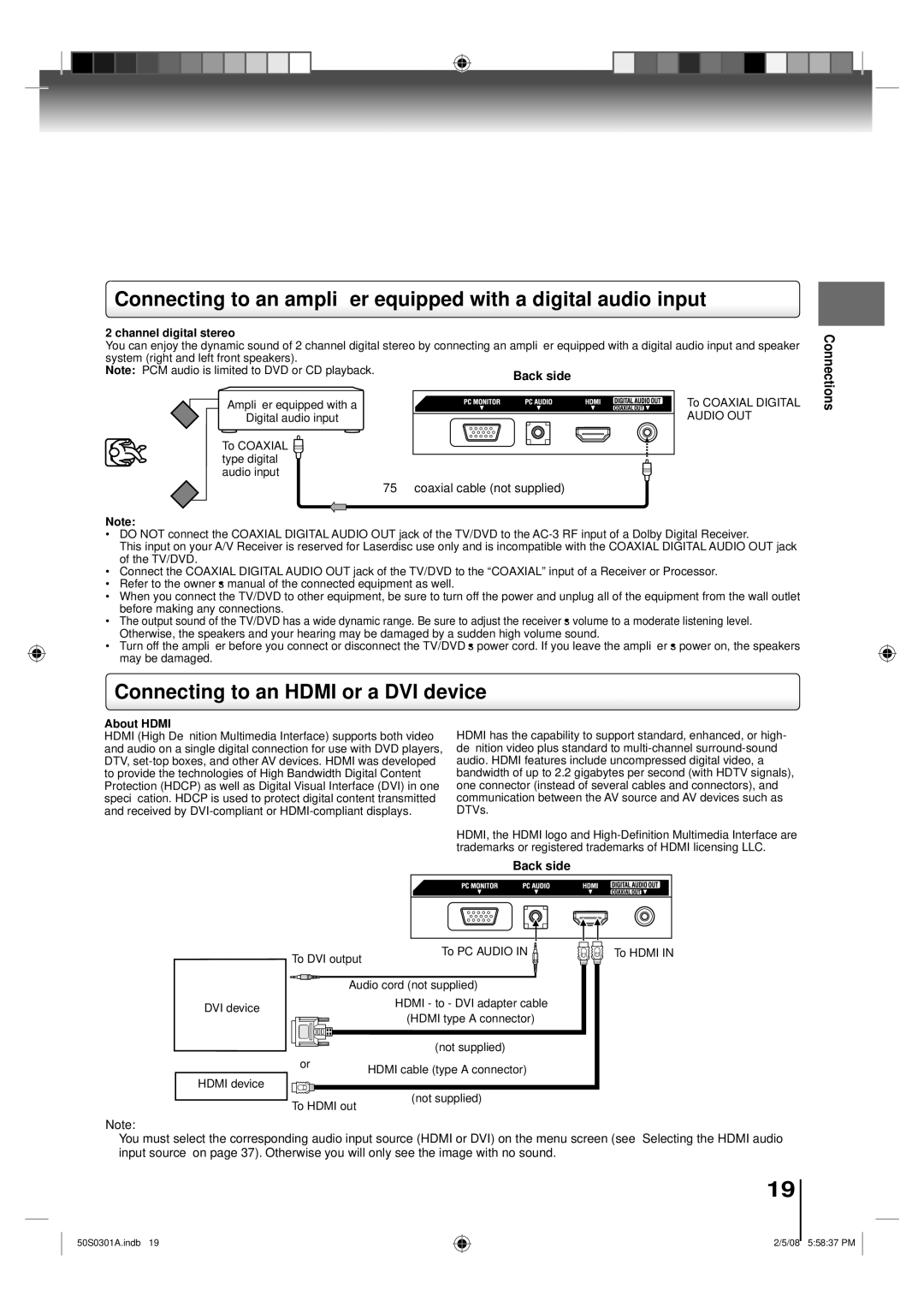Ownerʼs Record
19LV505C 22LV505C
Child Safety
Introduction
Location of the required Marking
Manufacturer, or sold with
Installation
Safety Instructions
Choosing a location for your LCD TV
Precautions
Important notes about your LCD TV
On handling discs
Precautions /Notes on discs
On cleaning discs
Structure of disc contents
On Video CDs
About this ownerʼs manual
Playable discs
Contents
Front
Identification of controls
Side
Antenna jack
Rear
DVD Menu button
Remote control
Operation
Inserting batteries
Antenna connections
Connections
Cable TV connections
Using the audio/video inputs
Connecting to optional equipment
Ex. VCR with S-Video
Connecting to an optional equipment with S-video output
Ex. DVD player with Component video
Digital Theater Systems DTS
Connecting to an amplifier equipped with a DTS decoder
Dolby Digital
Back side
Channel digital stereo
Connecting to an Hdmi or a DVI device
To use AC power source
Connecting to optional equipment Power source
Connecting to a PC Personal Computer
Power source
Press or to select Air or Cable
Auto Setup
Auto Setup
Press or to select Signal Type, then
Setting the language
Setting the language
Press or to select Language
Air/Cable selection
To memorize channels
Automatic search
Press or to select the channel that you Want to skip
Add/Delete channel
Select Channel, then press or Enter
Press or to select Add/Delete, then Press or Enter
Clear All
Adding Channel
TV operation
TV operation
Operation
Mute CH RTN
Press or to select a channel you want to label, then press
Labeling channels
Press or to select Ch Label, then
Press or Enter Ch Label menu will appear
Labeling video inputs
Select Setup, then press or Enter
Press or to select Video Label, then press or Enter
Press or to select CC Setting, then press or to select On
Setting the closed captions
CC advanced
CC advanced
Adjusting the picture preference
Adjusting the picture preference/ Picture settings
Picture settings
Theater Wide2 picture size for letter box programs
Viewing the wide-screen picture formats
Viewing the wide-screen picture formats
Theater Wide1 picture size for 43 format programs
Press or to select On or Off
Film Mode
Press or to select Film Mode
Film Mode/DNR
Picture control adjustment in the PC mode
Picture control adjustment in the PC mode
Press INPUT, then press / or 4 to select
Select Audio, then press or Enter
Sound control adjustment
Selecting Stereo/Second Audio Program SAP
Select Audio , then press or Enter
Selecting the Hdmi audio input source
Selecting the audio language
Select Setup , then press or Enter
Using the aspect feature Adjusting the back lighting
Using the aspect feature
Adjusting the back lighting
Press or to select Reset
Setting the Auto Shut Off Resetting your settings
Setting the Auto Shut Off
Resetting your settings
Vcdcd Basic playback
Playing a disc
Basic playback
VCD Basic playback
VCD Locating a chapter or track
Vcdcd Playing in fast reverse or fast forward directions
Dvdvcd Playing frame by frame
DVD Playing in slow-motion
VCD Zooming
Zooming/Locating desired scene
VCD Locating desired scene
Dvdvcd Returning to the scenes
To cancel the Marker
Marking desired scenes
Dvdvcd Marking the scenes
Dvdvcd Repeat playback
Repeat playback/A-B Repeat playback
VCD A-B Repeat playback
VCD Program playback
Program playback/Random playback
CD Random playback
DVD menu
Changing angles/Title selection/DVD menu
Changing angles
Title selection
Case of Video CD playback
Changing soundtrack language/Subtitles
DVD VCD Changing soundtrack language Subtitles
Press Audio Select during playback
VCD To turn off the PBC see
Press Play Mode in the stop mode
Disc status/To turn off the PBC
Dvdvcd Disc status
Limitations on display
MP3/WMA/JPEG/DivX and Audio CD operation
CD Audio CD/MP3/WMA/JPEG/DivX CD information
Limitations on MP3/WMA/JPEG/DivX CD playback
file browser screen will appear on the screen
CD MP3/WMA and Audio CD playback
Select Files
Preparation
MP3/WMA/JPEG/DivX and Audio CD
Operation
CD Jpeg playback CD Slide show playback
Press Stop to end playback
CD Playing DivX VOD content
CD DivX playback
Press / to select file
CD Random playback Audio CD/ MP3/WMA/JPEG/DivX
Repeat, random and program playback using file browser
file browser, press / / / to select Repeat during stop mode
CD Repeat playback Audio CD/ MP3/WMA/JPEG/DivX
Program View
CD Program playback Audio CD/MP3/WMA/JPEG/DivX
VCD Setting procedure
Customizing the function settings
Then press or ENTER. The selectable settings will appear
Setting details
Original Audio
Menu, Subtitle, Audio
English, Francais, Espanol
Other
Bitstream
Night Mode
Digital Out
Off
DivX VOD
Parental control setting
Set the new password
If you forget the password
Playback will commence if the entered password is correct
DVD Temporary cancel the rating level by DVD disc
Load a DVD disc
Troubleshooting
Understanding the Power Return feature
Make sure the connection of AC cord is secured
Others
Symptoms Possible Solutions DVD
Ignition
Reception disturbances
Language Name Code
Language code list
Model 19LV505C 22LV505C General
Specifications
Others Rental Units
Limited One 1 Year Warranty on Parts and Labour
Limited Warranty for Commercial Units
Your Responsibility
Critical Applications
Arbitration and Dispute Resolution
How to Obtain Warranty Services
Disclaimer and Limitation of Remedy

![]() type digital audio input
type digital audio input